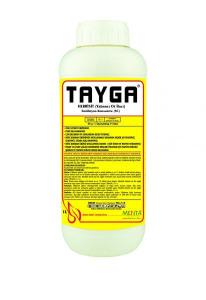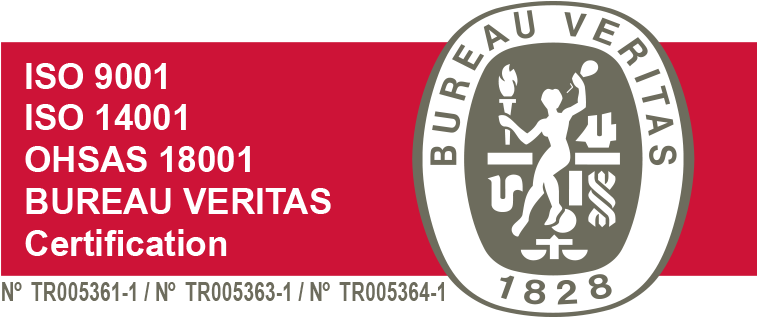Product Certificate and Label
Name of Product : TAYGA
Active Substance : 50 g/L Quizalofop-P-ethyl
Formulation Type : Emulsion Concentrate (EC)
Feature : It is a selective herbicide used after emergence in the control against single and perennial narrow leaf weeds.
Group : 1-A HERBICIDE
Antidote : It has no special antidote. It is treated according to the symptoms.
Type of Market Release : 1 L
PREPERATION OF THE PESTICIDE FOR APPLICATION
The plant protection product calculated over the recommended dosage is first mixed with some water in a separate container. The tank of the application machine is half filled with water. Medicated water is added to the tank while the mixer of the machine is running. The mixing is continued and the tank is completed with water. Mixing is continued until the application is completed. The amount of water to be used per decare should be 20-40 liters, and fan jet nozzle should be used in applications. Use the prepared plant protection product on the same day.
MISCIPLITY
It is not recommended to be mixed with other products.
USAGE AND TIME
TAYGA is used by spraying on weeds in young periods when weeds have 3-6 leaves and they show a rapid development (for Kanyaş, this period is 30 cm weeds). A good coating should be provided in applications. It should not be applied in dry conditions and low temperatures where weeds are very slow to develop.
INFORMATION ABOUT RESISTANCE:
The plant protection product TAYGA is a herbicide classified as Group A:1 according to its mechanism of action.
Repetitive applications of plant protection products with the same mechanism of action promote resistance development.
For this reason, in order to delay the development of resistance, do not exceed the total number of applications
recommended in the same season of TAYGA. In cases where the application should be repeated, pay attention
to the use of plant protection products with different action mechanisms (other than Group A:1). Always follow the recommendations on the label.
|
PLANTS AND WEEDS IT IS USED FOR PLANT AND HARMFUL ORGANISMS TO BE USED: |
||
|
Plant Name |
Harmful Organism Name |
Dosage and Application Time |
|
Vineyard* |
Cynodon dactylon Johnson Grass (Sorghum hale pense) |
100 ml / da Cynodon dactylon 15-20 cm While Johnson Grass in 2-3 siblings |
|
Tomato |
Cynodon dactylon Cockspur Grass (Echinochloa crusgalli) Johnson Grass (Sorghum halepense) |
100 ml/da Tomatoes 15-20 cm tall, weeds 3-6 leaves after growing |
|
Sunflower |
Fleabane (Alopecurus myosuroides) Downy Chess (Bromus spp.) Cynodon dactylon Cockspur Grass (Echinochloa crusgaili) Wild barley (Hordeum spontaneum) Wild maize (Panicum spp) Downy brome (Poa spp.) (Setaria spp.) Johnson Grass (Sorghum halepense) |
100 ml/da During the period sunflower and weeds have 3 - 4 leaves, after growing |
|
Onion |
Cockspur Grass (Echinochloa crusgaili) (Setaria spp.) Johnson Grass (Sorghum halepense) |
100 ml/da When the onion is 5-20 cm tall, Johnson Grass has 3-5 leaves, Cockspur Grass and Setaria spp. are 10-15 cm tall. |
|
Red Lentil |
Fleabane (Alopecurus myosuroides) Infertile Wild Oat Grass (Avena steril is) Self growing barley(Hordeum vulgare) Self growing wheat(Triticum aestivum) |
75 ml/da When the lentils are 8-12 cm tall, during the period when weeds have 2-4 leaves, after growing |
|
Red Lentil |
Couch grass(Elymus repens) |
100 ml/da When the lentils are 8-12 cm tall, during the period when weeds have 2-4 leaves, after growing |
|
Sugar Beet |
Fleabane (Alopecurus myosuroides) Wild oat(Avena fatua) Downy brome (Bromus teetorum) Cockspur Grass (Echinochloa crusgalli) |
75-100 ml/da Low doses are applied in annual weeds and high doses are applied in perennial weeds. |
|
Cotton |
Johnson Grass (Sorghum halepense) |
75-100 ml/da Low doses are applied in seeds and high doses in rhizomes. |
|
Soy Bean |
Fleabane (Alopecurus myosuroides) Cynodon dactylon Cockspur Grass (Echinochloa crusgalli) Canary seed(Phalaris spp.) Wild maize (Panicum spp.) Johnson Grass (Sorghum halepense) |
100 ml/da In the period where weeds have 3-6 leaves, after growing |
|
Canola |
Italian Ryegrass (Lolium temulentum) |
200 ml/da After growing |
|
Canola |
Fleabane (Alopecurus myosuroides) Cynodon dactylon Canary seed(Phalaris spp.) Wild maize (Panicum spp.) (Setaria spp.) Downy brome (Poa spp.) Infertile wild oat (Avena sterilis) Self growing wheat (Triticum aestivum) |
100 ml/da After growing |
|
Chickpea |
Fleabane (Alopecurus myosuroides) Wild oat(Avena fatua) Self growing wheat (Triticum aestivum) |
75 ml/da After growing |
|
|
|
PLANTS AND WEEDS IT IS USED FOR PLANT AND HARMFUL ORGANISMS TO BE USED: |
||
|
Plant Name |
Harmful Organism Name |
Dosage and Application Time |
|
Vineyard* |
Cynodon dactylon Johnson Grass (Sorghum hale pense) |
100 ml / da Cynodon dactylon 15-20 cm While Johnson Grass in 2-3 siblings |
|
Tomato |
Cynodon dactylon Cockspur Grass (Echinochloa crusgalli) Johnson Grass (Sorghum halepense) |
100 ml/da Tomatoes 15-20 cm tall, weeds 3-6 leaves after growing |
|
Sunflower |
Fleabane (Alopecurus myosuroides) Downy Chess (Bromus spp.) Cynodon dactylon Cockspur Grass (Echinochloa crusgaili) Wild barley (Hordeum spontaneum) Wild maize (Panicum spp) Downy brome (Poa spp.) (Setaria spp.) Johnson Grass (Sorghum halepense) |
100 ml/da During the period sunflower and weeds have 3 - 4 leaves, after growing |
|
Onion |
Cockspur Grass (Echinochloa crusgaili) (Setaria spp.) Johnson Grass (Sorghum halepense) |
100 ml/da When the onion is 5-20 cm tall, Johnson Grass has 3-5 leaves, Cockspur Grass and Setaria spp. are 10-15 cm tall. |
|
Red Lentil |
Fleabane (Alopecurus myosuroides) Infertile Wild Oat Grass (Avena steril is) Self growing barley(Hordeum vulgare) Self growing wheat(Triticum aestivum) |
75 ml/da When the lentils are 8-12 cm tall, during the period when weeds have 2-4 leaves, after growing |
|
Red Lentil |
Couch grass(Elymus repens) |
100 ml/da When the lentils are 8-12 cm tall, during the period when weeds have 2-4 leaves, after growing |
|
Sugar Beet |
Fleabane (Alopecurus myosuroides) Wild oat(Avena fatua) Downy brome (Bromus teetorum) Cockspur Grass (Echinochloa crusgalli) |
75-100 ml/da Low doses are applied in annual weeds and high doses are applied in perennial weeds. |
|
Cotton |
Johnson Grass (Sorghum halepense) |
75-100 ml/da Low doses are applied in seeds and high doses in rhizomes. |
|
Soy Bean |
Fleabane (Alopecurus myosuroides) Cynodon dactylon Cockspur Grass (Echinochloa crusgalli) Canary seed(Phalaris spp.) Wild maize (Panicum spp.) Johnson Grass (Sorghum halepense) |
100 ml/da In the period where weeds have 3-6 leaves, after growing |
|
Canola |
Italian Ryegrass (Lolium temulentum) |
200 ml/da After growing |
|
Canola |
Fleabane (Alopecurus myosuroides) Cynodon dactylon Canary seed(Phalaris spp.) Wild maize (Panicum spp.) (Setaria spp.) Downy brome (Poa spp.) Infertile wild oat (Avena sterilis) Self growing wheat (Triticum aestivum) |
100 ml/da After growing |
|
Chickpea |
Fleabane (Alopecurus myosuroides) Wild oat(Avena fatua) Self growing wheat (Triticum aestivum) |
75 ml/da After growing |




